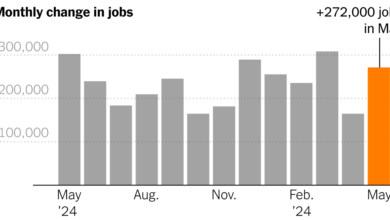Anthony Insolia, Who Led the Expansion of Newsday, Dies at 98

Anthony Insolia, a down-to-earth former editor of Newsday who presided over that Long Island newspaper’s expansion and several big investigative projects, died on Saturday in Philadelphia. He was 98.
His death, in a hospice, was confirmed by his stepdaughter, Robin Ireland.
Mr. Insolia was the editor of Newsday from late 1977 until his retirement 10 years later, a period when the newspaper, a tabloid owned then by the Times Mirror Co., won seven Pulitzer Prizes, expanded its foreign reporting staff to multiple far-flung bureaus and solidified its reputation for hard-hitting, streetwise journalism close to home.
But it was an undertaking a year before he took charge of Newsday that was among his most significant journalistic accomplishments: what came to be known as the Arizona Project, a pioneering effort in collaborative journalism across many news organizations.
Mr. Insolia, who was Newsday’s managing editor at the time, was the story editor on the project, which was mounted in response to the murder of an Arizona reporter, Don Bolles, in 1976.
Mr. Bolles was fatally injured when his car was blown up in a Phoenix parking lot in June 1976 as he was investigating ties between Arizona politicians, businesses and organized crime. A then-fledgling organization, Investigative Reporters and Editors, or I.R.E., assembled a team of 38 journalists from 28 news organizations under the leadership of the Newsday reporter and editor Robert W. Greene to look into the circumstances of the killing and, as he put it, to make people “think twice” about killing journalists.
The project produced a series of 23 articles in 1977, all appearing in cooperating newspapers across the country, including The Indianapolis Star, The Tulsa Tribune, The Miami Herald, The Boston Globe and Newsday. Carrying on Mr. Bolles’ work in trying to demonstrate those mob ties, the series “shook the Arizona establishment to its foundations,” Ed DeLaney, the former counsel to I.R.E., recalled in a 2008 article in the organization’s bulletin.
Mr. Insolia had also been Newsday’s managing editor for a 1974 project, “The Heroin Trail,” which traced the flow of heroin from Turkey’s poppy fields to suburban Long Island. It won the Pulitzer for public service.
“He was very granular, but he had big thoughts and dreams,” said Jim Mulvaney, who headed several foreign bureaus under Mr. Insolia. “He was a fan of good reporting. He would come over and point out when you had done something good.”
The opposite was true as well. Mr. Insolia was known for his uncompromising standards and “a relentless honesty that often crossed the line into bluntness and earned him the nickname ‘Tony Insult,’” Robert F. Keeler wrote in the 1990 book “Newsday: A Candid History of the Respectable Tabloid.” He credited Mr. Insolia with “impeccable news judgment and relentless attention to detail.”
In a 1986 interview on C-SPAN, Mr. Insolia proudly discussed his recent hiring of the New York Times columnist Sydney Schanberg to be a columnist for New York Newsday, the newspaper’s New York City offshoot (it was closed in 1995, as were the paper’s foreign bureaus eventually). Mr. Schanberg had left The Times after it discontinued his column in the wake of his public criticism of the newspaper’s coverage of the Westway project, the proposed highway on Manhattan’s West Side.
Asked if Mr. Schanberg would encounter similar difficulties at Newsday, Mr. Insolia gruffly replied, “These pages are here to represent as many points of view as possible.”
In the interview, he expressed absolute confidence in the future of newspapers and in their necessity, a judgment that predated the internet era. “The meat of a newspaper is explanatory,” Mr. Insolia said, adding, “I think people are reading newspapers, and they’re reading them carefully.”
Anthony Edward Insolia was born on Feb. 7, 1926, in Tuckahoe, N.Y., in Westchester County. His father, Salvatore Insolia, a Sicilian immigrant, was a presser in New York’s garment district; his mother, Pasqualina (Beladino) Insolia, was a seamstress.
He attended schools in Mount Vernon, N.Y., and was drafted into the Army in 1944, assigned to Tempelhof Airport in Berlin as a ground station radio operator.
The first in his family to earn a college degree, Mr. Insolia graduated from New York University in 1949. He went to work as a reporter for The Yonkers Times while also holding a job at a Gristedes supermarket. He moved to Newsday as a reporter in the fall of 1955 and remained there for more than 30 years.
In addition to his stepdaughter, Ms. Ireland, he is survived by his second wife, Jean Insolia; his daughters, Anne Smyers and Janet Insolia; his son, Robert; his brother, Richard; nine grandchildren; two great-grandchildren; and a stepson, David Uris.
“If there is a human being that was temperamentally designed to be a journalist, it was him,” said Ms. Ireland, a former journalist herself who recalled his tough honesty when she showed him her articles. Mr. Insolia’s catchphrase, she recalled, was: “Nobody’s going to tell you how great you are. You’re going to have to do it on your own.”



